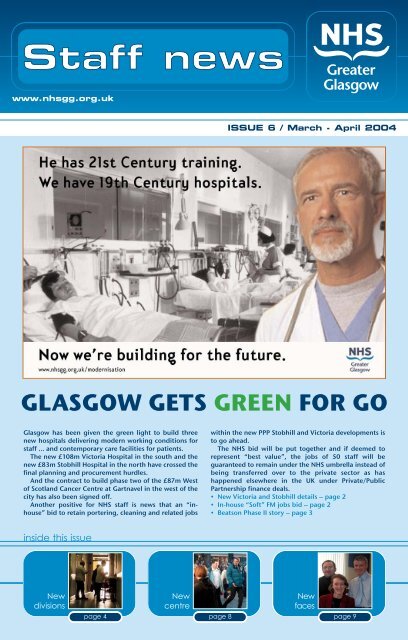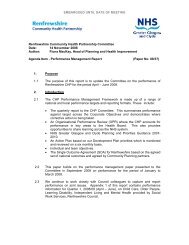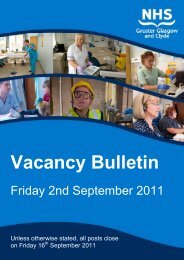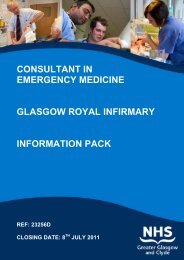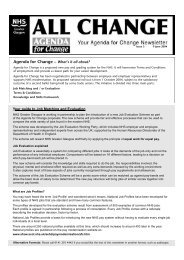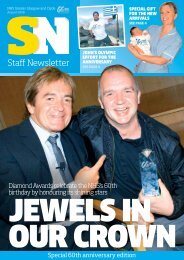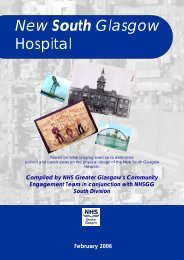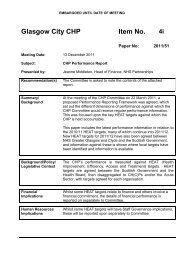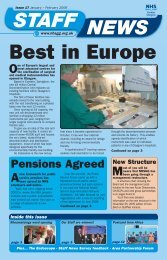GLASGOW GETS GREEN FOR GO - NHS Greater Glasgow and Clyde
GLASGOW GETS GREEN FOR GO - NHS Greater Glasgow and Clyde
GLASGOW GETS GREEN FOR GO - NHS Greater Glasgow and Clyde
- No tags were found...
Create successful ePaper yourself
Turn your PDF publications into a flip-book with our unique Google optimized e-Paper software.
www.nhsgg.org.ukISSUE 6 / March - April 2004<strong>GLAS<strong>GO</strong>W</strong> <strong>GETS</strong> <strong>GREEN</strong> <strong>FOR</strong> <strong>GO</strong><strong>Glasgow</strong> has been given the green light to build threenew hospitals delivering modern working conditions forstaff … <strong>and</strong> contemporary care facilities for patients.The new £108m Victoria Hospital in the south <strong>and</strong> thenew £83m Stobhill Hospital in the north have crossed thefinal planning <strong>and</strong> procurement hurdles.And the contract to build phase two of the £87m Westof Scotl<strong>and</strong> Cancer Centre at Gartnavel in the west of thecity has also been signed off.Another positive for <strong>NHS</strong> staff is news that an “inhouse”bid to retain portering, cleaning <strong>and</strong> related jobswithin the new PPP Stobhill <strong>and</strong> Victoria developments isto go ahead.The <strong>NHS</strong> bid will be put together <strong>and</strong> if deemed torepresent “best value”, the jobs of 50 staff will beguaranteed to remain under the <strong>NHS</strong> umbrella instead ofbeing transferred over to the private sector as hashappened elsewhere in the UK under Private/PublicPartnership finance deals.• New Victoria <strong>and</strong> Stobhill details – page 2• In-house “Soft” FM jobs bid – page 2• Beatson Phase II story – page 3inside this issueNewdivisionspage 4Newcentrepage 8Newfacespage 9
WWW.<strong>NHS</strong>GG.ORG.UKp3What’s happeningwith the new Beatson?The £87million contract for the new phase of the West ofScotl<strong>and</strong> Cancer Centre (affectionately known as theBeatson) means changes to our non-surgical cancerservices are on the horizon. But what’s in the workpipeline for cancer staff?Beatson General Manager, Isobel Neil, said: “At themoment, specialist cancer staff are spread all over varioussites in North <strong>Glasgow</strong>, but when the building is up-<strong>and</strong>runningin 2007, they will be transferred there. We willcontinue to brief staff as we go along.”<strong>NHS</strong>GG’s non-surgical cancer services are currentlymade up of:• The existing Beatson Oncology Centre on the WesternInfirmary site;• <strong>Glasgow</strong> Royal Infirmary’s St Mungo Unit;• Haemato-oncology beds at Stobhill Hospital;• Gartnavel General’s cancer treatment ward;• The radiotherapy outpatients section of the Beatson (theTom Wheldon building) on the Gartnavel General site.ST MUN<strong>GO</strong> STAFFMOVE TO BEATSONSeven medical oncology beds from the St Mungo Unitat <strong>Glasgow</strong> Royal Infirmary have been transferred toWard G10 at the Western-based Beatson. As part ofthis arrangement three nurses have moved over to theBeatson.The staff were originally due to transfer to the newWest of Scotl<strong>and</strong> Cancer Centre when it opens on theGartnavel site in 2007.For some time Beatson medical staff have, as part oftheir overall duties, covered the St Mungo Unit <strong>and</strong>there has been a gradual reduction in the need for<strong>and</strong> use of medical oncology beds at GRI.The recent retirement of the consultant working atthe unit has meant the small number of medicaloncology beds at GRI can no longer be sustained.In addition, there are also other pressures such aschanges in working <strong>and</strong> training regulations formedical staff.As a result action to transfer the beds to the Beatsonhas been taken to ensure the service can continue.The vast majority of medical oncology patientstreated at GRI are either day case or outpatients <strong>and</strong>both these services will continue to be provided atGRI.The Bone Marrow Transplant <strong>and</strong> haematologyoncologyservice will remain at GRI’s St Mungo Unit<strong>and</strong> will have more dedicated beds as a result of thistransfer. This service will move, as planned, to thenew West of Scotl<strong>and</strong> Cancer Centre in 2007.An artist’s impression of what the new Beatson might look like.Isobel added: “It will be excellent for cancer staff <strong>and</strong>patients to be together in a brilliant new cancer centre.“As well as having state-of-the treatment facilities, thebuilding’s interior will be designed to promote a sense ofwellbeing among patients <strong>and</strong> staff, <strong>and</strong> the project teamplans to appoint an artistic advisor who will help todevelop a therapeutic environment.“This approach was pioneered by the <strong>Glasgow</strong>Homeopathic Hospital, also on the Gartnavel site, whereit has proved tremendously successful. We know thatusing the right colours, finishes <strong>and</strong> furniture can createpositive surroundings for patients <strong>and</strong> a pleasant workingenvironment for staff.”The finished product will stretch over five floors, whichwill include three floors of inpatient wards; varied patient<strong>and</strong> family information services; a pharmacy; outpatientareas with state-of-the-art scanning equipment; clinicaltrial <strong>and</strong> research space; <strong>and</strong> an education suite foreverything from student lectures to long-distancemedical image <strong>and</strong> video links with other cancerspecialists. The Tom Wheldon building will solely be usedfor outpatient radiotherapy.<strong>NHS</strong> <strong>Greater</strong> <strong>Glasgow</strong> Chief Executive Tom Divers said:“Patients <strong>and</strong> staff will undoubtedly benefit from thelong-awaited development of the new West of Scotl<strong>and</strong>Cancer Centre. It will be one of the finest specialistoncology units in the world.”BOC Medical Director Professor Alan Rodger added:“All staff involved have worked hard to get the project tothis stage <strong>and</strong> I know they will be very pleased with theend result. Our staff, patients <strong>and</strong> their families deservethe very best, <strong>and</strong> thanks to the development of the newWest of Scotl<strong>and</strong> Cancer Centre they will receive this.”Construction is due to start in July.
p4WWW.<strong>NHS</strong>GG.ORG.UKEmployed by the Board instead of your Trust…What does it mean?The world as we know it won’t change on April 1 …despite rumours to the contrary!The <strong>NHS</strong> has experienced many overhauls in recentyears – this time it is a move toward single-systemworking bringing an end to the four Trusts operating in<strong>Greater</strong> <strong>Glasgow</strong>.YOUR SERVICE,YOUR SAYPlans are underway to organise a major event on April23, 2004 aimed at informing <strong>and</strong> developing acommon strategy for Patient Focus <strong>and</strong> PublicInvolvement (PFPI) across <strong>NHS</strong> <strong>Greater</strong> <strong>Glasgow</strong>.The event, with the working title of ‘Your Service,Your Say’, is to be staged at Celtic Park’s conferencecentre.Around 130 public, patient <strong>and</strong> voluntary sectorrepresentatives will be invited to join <strong>NHS</strong> BoardMembers, managers, clinicians <strong>and</strong> support staff atthe event.Developing a new strategy for PFPI is necessarybecause of organisational changes resulting from‘single system working’ after the April 1, 2004. Newlegislative responsibilities for the local healthcaresystem arising from the <strong>NHS</strong> Reform Bill are anotherimportant factor.April 1 is the date circled for all of <strong>Glasgow</strong>’s 33,000<strong>NHS</strong> staff to come under the single employment umbrellaof GG <strong>NHS</strong> Board.That’s the date when our four <strong>NHS</strong> Trusts cease to existas Trusts <strong>and</strong> become operational divisions.SO WHAT DOES IT ALL MEAN TO YOU?Your line manager does not change; your pay <strong>and</strong>conditions of employment do not change. The term“Trust” will be dropped <strong>and</strong> replaced with “division”.Discussions are ongoing as to the exact wording of thesedivisions.Some staff have asked about changing name badges.Others have asked about hospital signs being replaced<strong>and</strong> any need to create new headed notepaper. Generallythere is no desire to divert hard-pressed resources intoreplacing existing materials.As when the new corporate <strong>NHS</strong> logo was adoptedthroughout Scotl<strong>and</strong> a couple of years ago, thechangeover should be phased in as <strong>and</strong> when existingstocks of materials run out.Meanwhile a huge amount of work is underway, withthe full involvement of the Staff Partnership, to driveforward the single system evolution which aims toidentify more effective <strong>and</strong> collaborative ways of workingto deliver services.One of the biggest impacts we will see is theintroduction of Community Health Partnerships in placeof Local Health Care Co-operatives. For more details ofCHP progress please turn to page 7.Staff News will endeavour to keep everyone up-to-datewith progress in future editions.
WWW.<strong>NHS</strong>GG.ORG.UKp5So what’s all this about gradereviews <strong>and</strong> terms <strong>and</strong> conditions?The Agenda for Change Project Steering Group: (front, left to right) Rona Agnew, Janice Whitelaw, Jonathan Best(joint chair), Elizabeth Stow (joint chair), Caroline Fee, Paul Watt; (back, left to right) Jennifer Crockett, StewartMacLellan, Irene Shields, Rosslyn Crocket, Jim Whyteside <strong>and</strong> Donald Sime. Not pictured, but part of the team:Andy Carter, Alan Boyter, Billy Hendry, Jane McCready, Julie McQueen, Marjorie Mullins, Isobel Quarrell, Ian Reid.Let’s get it clear … there’s a lot of confusion about.Partnership For Care is about changing the way we allwork together to deliver services … Agenda For Change isabout making sure <strong>NHS</strong> employees throughout the UK aretreated equally wherever they work.It’s a plan to ensure terms <strong>and</strong> conditions <strong>and</strong> gradesare consistent <strong>and</strong> the aim is to work towardimplementation by or soon after October 2004.<strong>NHS</strong> <strong>Greater</strong> <strong>Glasgow</strong> has begun work on the keyelements of the Pay Modernisation programme inpartnership with staff-side organisations.Jonathan Best, Chief Executive at Yorkhill, <strong>and</strong> ElizabethStow, Society of Radiographers, jointly chair <strong>Glasgow</strong>’sProject Steering Group which has been established toplan <strong>and</strong> prepare for the “harmonisation” of wages <strong>and</strong>conditions.The project group will have six sub-groups focusing onspecific aspects of the proposals.The following staff-side chairs have been nominated bythe Area Partnership Forum:Rona Agnew (management group); Jennifer Crockett(communications); Caroline Fee (jobmatching/evaluation); Stewart MacLennan (terms <strong>and</strong>conditions); Jane McCready (finance); Isobel Quarrell(knowledge <strong>and</strong> skills framework/organisationaldevelopment).A programme of events will take place over the next fewmonths to inform staff across <strong>NHS</strong> <strong>Greater</strong> <strong>Glasgow</strong> aboutprogress– look out for details of events in your area. StaffNews will provide updated reports in every edition.If you have views to make, concerns to raise … sendthem to staffnews email address: staffnews@nhsgg.org.ukor Olivia Cornacchia, Dalian House, 350 St Vincent Street,<strong>Glasgow</strong> (olivia.cornacchia@gghb.scot.nhs.uk).Want to Help Improve Services for Patients?If the answer’s ‘yes’ then why not think about applying for one of the five staff places on <strong>NHS</strong>GG’s Service RedesignCommittee.Chaired by Dr John Nugent, the committee aims to look at the redesign of services including: how <strong>and</strong> whereservices are provided; affordability <strong>and</strong> efficiency; making sure we provide quality services with the resources we’vegot.If you are interested in becoming a staff member to this Committee, (time will be given for attendance atmeetings) please submit your expression of interest or nomination to Shirley Gordon, Service Redesign CommitteeCo-ordinator, Dalian House, 350 St Vincent Street, <strong>Glasgow</strong>, G3 8YZ or by email to shirley.gordon@gghb.scot.nhs.uk.
WWW.<strong>NHS</strong>GG.ORG.UKp7Initial proposalsfor CHPs unveiledCloser working for community, hospital <strong>and</strong> social care staff<strong>NHS</strong>GG has just unveiled initial proposals for thedevelopment of Community Health Partnerships (CHPs)for <strong>Greater</strong> <strong>Glasgow</strong> – so what are they <strong>and</strong> what do theymean for <strong>NHS</strong> staff?Responsible for managing a wide range of local healthservices <strong>and</strong>, with the agreement of local authorities,possibly other socialcare services, CHPs willsee community basedhealth staff workingeven more closely withtheir local authority<strong>and</strong> hospital basedWest Dunbartonshire CHPcolleagues to improvepatient care.Ian Reid, joint chairof the <strong>Greater</strong> <strong>Glasgow</strong>WesternCHP Steering Group,said: “CHPs will buildon the work of ourSouth Westexisting Local HealthCare Co-operatives(LHCCs), but will belarger organisationswithwider<strong>NHS</strong> <strong>Greater</strong> <strong>Glasgow</strong> Arearesponsibilities <strong>and</strong><strong>NHS</strong> Argyle & <strong>Clyde</strong> Areagreater influence.<strong>NHS</strong> Lanarkshire Area<strong>Glasgow</strong> City Council Boundary“They will developWest Dunbartonshire Council Areacloser partnerships withEast Dunbartonshire Council AreaNorth Lanarkshire Council Arealocal authorities <strong>and</strong>South Lanarkshire Council Areahospitals to break downEast Renfrewshire Council Areasome of the barriers thathave traditionallyexisted between community health, social care <strong>and</strong>secondary health services.”The proposals, which have been developed with <strong>NHS</strong><strong>Greater</strong> <strong>Glasgow</strong>’s six partner local authorities, includeplans to develop eight CHPs in the following areas:• Five in the area served by <strong>Glasgow</strong> City Council(Eastern, Northern, Western, South East <strong>and</strong> SouthWest <strong>Glasgow</strong>);• One in the area served by East Dunbartonshire Council;• One in the area served by West DunbartonshireCouncil;• One in the area served by East Renfrewshire Council.<strong>NHS</strong> <strong>Greater</strong> <strong>Glasgow</strong> is also working with North <strong>and</strong>South Lanarkshire Councils to develop boundaryproposals for the CHPs which will cover theRutherglen/Cambuslang <strong>and</strong> Stepps/Moodiesburn areasof <strong>Greater</strong> <strong>Glasgow</strong>. As these Lanarkshire CHPs <strong>and</strong> theproposed West Dunbartonshire <strong>and</strong> East RenfrewshireCHPs also cover areas which are served by neighbouringhealth boards, they would be developed in partnershipwith <strong>NHS</strong> Lanarkshire<strong>and</strong> <strong>NHS</strong> Argyll <strong>and</strong><strong>Clyde</strong>.Once initial principles<strong>and</strong> boundaries havebeen finalised moredetailed plans on howCHPs will be organised<strong>and</strong> resourced will bedeveloped. This workStepps/will be done inMoodiesburnconsultation with staff<strong>and</strong> partner agenciesEastern <strong>Glasgow</strong> CHPwith the aim of havingthe new CHPs in place byRutherglen/CambuslangApril 2005.As well as workingcloselywithindependent healthcontractors, such asGPs,dentists,pharmacists <strong>and</strong>opticians, it is proposedthat CHPs will take overthe management of allexisting servicesprovided by LHCCs,including health visiting, district nursing, communitybasedoral health, physiotherapy, dietetic, speech <strong>and</strong>language <strong>and</strong> footcare services. In addition, it is proposedthat CHPs should manage school nursing services <strong>and</strong>local community-based health promotion teams.Proposals on how CHPs should work with a number ofother related services will be developed once boundarieshave been finalised.Information: www.nhs.gg.org.uk or 0141 211 3860.Comments (by March 31, 2004) to: John C Hamilton,Developing Community Health PartnershipsConsultation, <strong>NHS</strong> <strong>Greater</strong> <strong>Glasgow</strong>, Dalian House, 350 StVincent Street, <strong>Glasgow</strong> G3 8YZ (email:chp@nhsgg.org.uk).Northern <strong>Glasgow</strong> CHP<strong>Glasgow</strong> CHP<strong>Glasgow</strong> CHPEast Renfrewshire CHPEast Dunbartonshire CHPSouthEast<strong>Glasgow</strong>CHP
p8WWW.<strong>NHS</strong>GG.ORG.UKScotl<strong>and</strong>’s sickest cityThe last couple of editions of the Staff News have hadarticles updating staff on the progress in establishing theCentre for Population Health, but a lot of staff have beenasking: what is the Centre for Population Health <strong>and</strong> whatdoes it do?The Centre has alreadyachieved a high academicprofile, arousing considerableinterest in the West of Scotl<strong>and</strong><strong>and</strong> beyond. But what will theCentre do for local people?Dr Carol Tannahill, ProjectManager, is busy making surepolicymakers, practitioners,academics <strong>and</strong> local people areaware of the role the Centre for Dr Carol Tannahill.Population Health will play in<strong>Glasgow</strong>.She said “There are huge challenges to be addressed inmoving <strong>Glasgow</strong> up the health league table, but theCentre for Population Health has already provided a focusfor new thinking <strong>and</strong> added momentum.“This is a very exciting opportunity to build on existingstrengths <strong>and</strong> to bring a wide range of players together inunderst<strong>and</strong>ing <strong>and</strong> acting to make a real difference to thehealth of Glaswegians.”A combination of social circumstances <strong>and</strong> behaviourshave created the health problems in <strong>Glasgow</strong> <strong>and</strong> theCentre aims:• to build up an underst<strong>and</strong>ing of what determines badhealth;• learn how to improve health;• <strong>and</strong> establish new ways of improving health.There have been some encouraging changes recently, inturn, but Glaswegians still lag behind the rest of Scotl<strong>and</strong>,who lag behind the rest of Europe.IMPROVING THE HEALTH OF THE NATION SPECIAL REPOHealth in <strong>Glasgow</strong> is improving. Each year, the chance ofthe average Glaswegian dying of heart disease or cancergets less.However, for some people living in the poorer areas ofthe city, health is not improving as fast as it could.Indeed, while <strong>Glasgow</strong>’s health is improving, health inthe rest of Scotl<strong>and</strong> is improving faster, so the gap inhealth between the poorer parts of <strong>Glasgow</strong> <strong>and</strong> the restof Scotl<strong>and</strong> appears to be getting wider.<strong>NHS</strong>GG, in partnership with <strong>Glasgow</strong> City Council <strong>and</strong>Universities in the city, is setting up a new centre toexamine in closer detail the reasons for our failure toimprove health faster in <strong>Glasgow</strong>.As well as trying to underst<strong>and</strong> better what createshealth in a city, the new Centre for Population Health willwork on new ways to narrow thehealth gap between ourselves<strong>and</strong> the rest of Scotl<strong>and</strong>.WHY ARE WEUNHEALTHY?When the National HealthService was introduced 55 yearsDr Harry Burns.ago, there was an expectationthat free access to healthcare would eventually eradicatemost illness. By the 1960s, it was clear that freehealthcare alone was not the answer. An alternativeapproach to creating health was necessary.By the 1970s, it was generally understood that it wasimportant to pay attention to economic <strong>and</strong> social wellbeingin communities if health was to improve. In 1978the Declaration of Alma Ata called on members of theWorld Health Organisation to tackle health inequalitiesby a series of economic <strong>and</strong> social measures addressingthe broader determinants of health.As part of this, community development has become an
WWW.<strong>NHS</strong>GG.ORG.UKp9fights backNew Faces inCommunityEngagementRT: DR HARRY BURNS, DIRECTOR OF PUBLIC HEALTHessential part of the health improvement process. At thesame time, the obvious need to influence healthdamagingbehaviours through health education <strong>and</strong>health promotion campaigns became an important partof public policy in documents such as “The Health of theNation.”With almost 40 years of activity aimed at improvinghealth, it would be surprising if health had not improved- <strong>and</strong> it has. However, health has not improved as fast inScotl<strong>and</strong> as it has in the rest of Europe <strong>and</strong> it has notimproved as fast in <strong>Glasgow</strong> as in the rest of Scotl<strong>and</strong>.At present, it would be fair to say that it is generallyunderstood that a variety of influences such asemployment, education, housing, genetics, early lifeexperiences, smoking, diet <strong>and</strong> exercise all contribute tohealth.What is not well understood is how these circumstances<strong>and</strong> behaviours act together to create or damage health.Nor is it known how best to influence this complexenvironment in ways that might support the creation ofhealth. This is the task set for the new <strong>Glasgow</strong> Centre forPopulation Health.Supported by the Scottish Executive, three of the majorpublic sector organisations in the city – <strong>NHS</strong> <strong>Greater</strong><strong>Glasgow</strong>, <strong>Glasgow</strong> City Council <strong>and</strong> the Universities in<strong>Glasgow</strong> – have given their commitment to work togetherin a sustained way, to change <strong>Glasgow</strong>’s place in thehealth league table. It is anticipated that the initialpartners will be joined by other organisations who arekeen to contribute to the Centre.From the outset, the Centre will seek to be inclusive <strong>and</strong>to draw on the experiences <strong>and</strong> insights of people fromdiverse walks of life. It will not simply be an organisationcarrying out research. Its prime task will be to make adifference to the health of the most disadvantaged in ourcommunity.Left to right: Mark, Kate <strong>and</strong> Dan.<strong>NHS</strong>GG’s Community Engagement Team has nowbeen boosted from one to four thanks to theappointment of three new members of staff.Mark McAllister, Kate Munro <strong>and</strong> Dan Harley willmake up the team along with Head of CommunityEngagement, Niall McGrogan.The Team’s role will be to work with <strong>Greater</strong><strong>Glasgow</strong> communities <strong>and</strong> health staff on some of thekey issues surrounding the building of the newhospitals (ACADs) at Stobhill <strong>and</strong> the Victoria.These include access to information, transportissues, access to premises, service changes, <strong>and</strong>employment opportunities.The members of the new team are:• Mark McAllister – Mark has extensive experience inworking with community projects in the eastend<strong>and</strong>, more recently, in Drumchapel. His new role willinclude working with projects involving communitytransport, he’ll be working with community groups<strong>and</strong> be looking to create employment opportunitiesthrough the building of the new Stobhill <strong>and</strong>Victoria hospitals.• Kate Munro – Kate helped established MatNet, thematernity users network, <strong>and</strong> chairs the MentalHealth Service Users Group. Kate will be focussingon the patient experience within the new hospitals<strong>and</strong> how the buildings can be made moreaccessible.• Dan Harley – Dan studied nursing in Aberdeen <strong>and</strong>latterly worked as nurse in London acute hospitals.Part of Dan’s role will be to work with older <strong>and</strong>disabled people <strong>and</strong> involving them in the changesthat are happening to services as a result of the newhospitals being built.
p10WWW.<strong>NHS</strong>GG.ORG.UKHospitals Helping UnemA hospital-based pilot initiative which helps joblesspeople back into the workforce has been inundated withapplicants.The new Working for Health in <strong>Greater</strong> <strong>Glasgow</strong> projectoffers unemployed people the opportunity to gainpractical experience working as support workers inhospitals across the cityFirst advertised at job clubs <strong>and</strong> job centres beforeChristmas, there was so much interest from potentialparticipants, the project was oversubscribed.<strong>NHS</strong>GG’s Mark McAllister, who is part of the projectcoordination team, said: “We’re delighted this newproject was so popular. Unfortunately, we couldn’t takeeveryone who applied, but 15 trainees have already takenpart, nine of whom were offered jobs. We also haveanother 19 trainees who are now in placementsthroughout <strong>Glasgow</strong> hospitals, shadowing health workers<strong>and</strong> picking up the vocational skills they need to get jobsin the <strong>NHS</strong>.”Trainees are given six weeks of work experience whichsees them taking up a variety of posts including catering,portering, administration, nursing assistants <strong>and</strong> medicallaboratory assistants. Training is provided on-the-job <strong>and</strong>by training provider, the WISE Group.At the end of that training period, they are thenguaranteed an interview for any support worker vacanciesDawn Fyfe enjoyed her time training in therecruitment department at the Southern General.
WWW.<strong>NHS</strong>GG.ORG.UKp11ployed Back Into WorkJames Alford is shown the ropes withinthe catering unit at the Southern General.that may arise throughout <strong>NHS</strong>GG.Mark revealed the initiative isn’t just about gettingunemployed people ‘job ready’ nor is it about fillingempty posts.He said: “Part of the challenge for the project is toovercome the stigma attached to unemployment.Returning to work after being out of a job for a long timecan be difficult for c<strong>and</strong>idates, but Working for Healthoperates to dispel the barriers <strong>and</strong> improve employmentopportunities for participants.”Another one of the aims of the project is to improveparticipants’ overall wellbeing.Mark said: “Employment is an excellent start towardsgood health. The project brings together workforceplanning <strong>and</strong> health improvement. Being in employmentis the first step towards physical <strong>and</strong> mental wellbeing.”So what did the trainees think? As the second largestemployer in <strong>Greater</strong> <strong>Glasgow</strong>, <strong>NHS</strong>GG particularlyappealed to two c<strong>and</strong>idates James Alford <strong>and</strong> Dawn Fyfe,who have been training at the Southern General Hospital.James (43) is training in hospital catering <strong>and</strong> views the<strong>NHS</strong> as a place that provides job security <strong>and</strong> the chanceto help others. He found out about Working for Healththrough the Gorbals Initiative. He has a personal interestin catering, since cooking is his hobby <strong>and</strong> revealed theproject has boosted his self-esteem.He said: “This placement has given me a great insightinto the <strong>NHS</strong>. You don’t need any qualifications orexperience to get on to this course <strong>and</strong> I’ve really enjoyedit. A benefit from this course is that I’ve started to eatmore healthily because of it.”Twenty-six-year-old Dawn aspires to be an auxiliarynurse <strong>and</strong> is keen on working with children, so the projectwas an excellent opportunity for her to find out aboutworking in the <strong>NHS</strong>.She found out about the project through her local jobcentre <strong>and</strong> told Staff News she feels more confident <strong>and</strong>secure since gaining her placement. Through the project,Dawn has had the chance to refresh skills from a previouscomputer course at college.She said: “The placement is important for me because Ihave two children <strong>and</strong> prefer to be in secure employment.I will definitely pursue a career in the <strong>NHS</strong>.”It is hoped that this type of initiative will become partof the mainstream means of recruitment <strong>and</strong> training in<strong>NHS</strong> <strong>Greater</strong> <strong>Glasgow</strong>.
p12WWW.<strong>NHS</strong>GG.ORG.UKImage courtesy of The Big IssuePCT Staff Helping the HomelessScotl<strong>and</strong>’s first health <strong>and</strong> social care centre for thehomeless has opened in the Gallowgate.Run by <strong>Glasgow</strong>’s Homeless Partnership, the newcustom-built £700K centre bringstogether <strong>Glasgow</strong>’s health <strong>and</strong>social care services for the homelessunder one roof for the first time.Not only that, it also includes anew dedicated GP servicespecifically for homeless people.Kate Benson, Primary CareHomeless Service Manager, said:“Health staff have been working in<strong>Glasgow</strong> to improve <strong>and</strong> develop The new centre.homeless health services for manyyears, but this is the first time wehave been able to bring togetherservices in an integrated, custombuiltcentre.“We’re delighted to be able tooffer our services in such highquality surroundings <strong>and</strong> feel thatthis is a major step forward inmeeting the health <strong>and</strong> social careneeds of <strong>Glasgow</strong>’s homelesspopulation.”She continued: “We’ll be seeing A patient chats to a GP.around 160 people at the centreeach week <strong>and</strong> offering a wide range of services,including nurse treatment clinics, methadone clinics,psychiatry, physiotherapy <strong>and</strong> dietician assessment,podiatry sessions, mental healthservices <strong>and</strong> resettlementassessments as well as childimmunisation <strong>and</strong> chronic diseasemanagement clinics.”The opening of the centre is partof a bigger plan to improve servicesfor homeless people. In the future,the Homeless Partnership aims toresettle homeless people into localcommunities where they will beable to access mainstream healthservices. When this happens,health staff based in the centre willbe transferred to work in localhealth services in communities toassist mainstream staff.So what’s happening to existinghomeless services being offeredoutwith the centre? Well, outreachservices will continue to deliver care<strong>and</strong> treatment in the 62 clinicsacross the city, including in thecity’s hostels <strong>and</strong> at the premises ofvoluntary organisations.
WWW.<strong>NHS</strong>GG.ORG.UKp13Artwork for hospitalsIt isn’t often you can say that a specialist legal journal ledto a cultural revolution. But consultant rheumatologistRajan Madhok of the <strong>Glasgow</strong> Royal Infirmary is one of thefew people who can.“It was through a chance reading of Summons, themagazine of the Medical <strong>and</strong> DentalDefence Union, that I was drawn to thecover picture, which was of a ship <strong>and</strong> wasvery unusual.”It turned out that the magazine had runa series of front covers showcasing works ofart that have been made available by anEdinburgh-based charity, Paintings inHospitals Scotl<strong>and</strong>, known as PiHS forshort.Roger Jones of PiHS revealed that the charity has inorigins in 1960’s London. He said: “There are nowoffshoots in York <strong>and</strong> Edinburgh. What we do is buypaintings, or take them on loan from artists <strong>and</strong>collectors, <strong>and</strong> then offer them to hospitals <strong>and</strong> otherhealthcare facilities in return for a nominal annual rental.Sixteen hundred paintings have been placed in 60locations around Scotl<strong>and</strong>.”Given all the pressures on the <strong>NHS</strong>, you could beforgiven for being cynical about art in hospitals.However, Dr Madhok is clear as to why it has a place inhealthcare: “This isn’t just the environment where wehelp patients to get well, it is also the place in which ourstaff work day in <strong>and</strong> day out. The <strong>NHS</strong> is about people –a bl<strong>and</strong>, impersonal, literally clinical environment betraysa failure to recognise that basic fact.”Dr Madhok is positive that art on the wards has veryspecific benefits: “It’s stimulating. Not only does it getpeople to take an interest in their surroundings, get theirminds off their illness <strong>and</strong> so result in a direct effect ontheir wellbeing, art is also a talking point. It encouragespeople to speak to one another about something totallyobjective, about which everyone’s opinion is valid.Barriers are broken down because whether you like ordon’t like a painting is not dependent on whether you area patient, a visitor or a member of staff.”It is Dr Madhok’s faith in the power of artthat one dreich February afternoon causedthe stairwell between the Royal Infirmary’srheumatology wards to be filled withpaintings, photos <strong>and</strong> collages of all possibleshapes, sizes <strong>and</strong> colours. Patients indressing gowns shuffled among staff in theirscrubs as they gave each <strong>and</strong> every piece theonce-over. Many had already earmarkedone particular work of art for the wallopposite their bed or workstation.It costs PiHS £25 to supply each painting for one year.The Royal Infirmary found the money to turn the walls ofthe rheumatology wards into a visual treat by pulling incontributions from a variety of sources, includingfundraisers like the Dorcas Society. No money was takenfrom mainstream patient care budgets.This is just the start of the relationship between theRoyal <strong>and</strong> the world of fine art.Kirsten Lloyd of PiHS is keen to show that artists haveeven more to offer the hospital: “The work makes a bigimpact very quickly on the wards – but with the largerspaces in the hospital, like the floorwells, we are lookingto commission original pieces.”One option being considered is to place a mobile in thehospital which will transform the fabric of the building.And what do patients think of the sudden outbreak ofcanvases in the rheumatology department?One, Jeanette Wilson, is definitely happy with what shesees. “It’s nice to see the pictures up. They brighten theward up – It was a bit dull before.”Spiritual care in the workplaceNot sure what to do when you come across religion inthe workplace? Well whether it’s to do with your own ora patient’s religious practices or you deal with patientswho would benefit from meditation or counselling,<strong>NHS</strong>GG’s new Spiritual Care Policy will help you.The new set of <strong>Greater</strong> <strong>Glasgow</strong> guidelines are beingapplied across the system - everywhere from cancer carewards to health centre admin offices.Covering a wide range of spiritual care areas, the newguidelines incorporate everything from the training ofstaff who are responsible for delivering spiritual care toreviewing (in conjunction with faith communities) ourfacilities so they fulfil everyone’s spiritual needs.The new policy has been put together by a SpiritualCare committee made up of representatives from theBoard <strong>and</strong> the Trusts, healthcare chaplaincy, faithcommunities, the Humanist Society of Scotl<strong>and</strong> <strong>and</strong> theHealth Council. There is additional representation forthose who have no faith.This committee will not only ensure the agreedchanges are put in place, but will monitor <strong>and</strong> evaluatethem over the coming years.John Hamilton, Head of Board Administration <strong>and</strong> akey player in the Spiritual Care Committee, explained:“In short, our new policy will ensure that we continuallyprovide healthcare that is responsive to thepsychological, emotional <strong>and</strong> spiritual needs of ourstaff <strong>and</strong> patients.
p14WWW.<strong>NHS</strong>GG.ORG.UKA safe pairof h<strong>and</strong>sHere’s a problem for you. Vancouver, on the westernseaboard of Canada, is known as the ‘friendly city’.S<strong>and</strong>wiched between the Pacific Ocean on one side <strong>and</strong>the Whistler’s Mountain ski resort on the other, the city isa concoction of wide, tree-line boulevards <strong>and</strong> laid-backcharm. So why give it all up to come <strong>and</strong> work for the <strong>NHS</strong>in <strong>Glasgow</strong>?It’s as well that the person The winning team.who can answer the questionjust happens to have a job thatis basically all about problemsolving.Kay Craig, native ofVancouver, is now a Moving<strong>and</strong> H<strong>and</strong>ling Co-ordinator forthe North <strong>Glasgow</strong> Trust: “Myfamily are originally from<strong>Glasgow</strong>, so I had been over fewtimes <strong>and</strong> fell in love with theplace. But, when I originallycame to live in the UK rather than just visit, it was inSevenoaks, Kent.“I took a job as an auxiliary at the local LeonardCheshire Home, <strong>and</strong> that’s when I realised I really wantedto be a nurse – which was ironic, as I had promised myselfI wouldn’t work in either waitressing ornursing.”This was 1996 <strong>and</strong> it wasn’t long before Kayheaded north. She didn’t quite reach herbeloved <strong>Glasgow</strong> though, as her nursingtraining was in Edinburgh. After qualifying,there was a short spell as an agency nursebefore she returned to Canada. But she sooncame back to Scotl<strong>and</strong> because of, as Kayherself puts it: “A man”. The ‘man’ was Paul,who is now her husb<strong>and</strong>.By January 2000, Kay had a job as a Theatre Nurse at the<strong>Glasgow</strong> Royal Infirmary. “I was scrubbing <strong>and</strong> doinganaesthetics <strong>and</strong> I loved every minute of it. It was a logicalprogression from that into moving <strong>and</strong> h<strong>and</strong>ling.”Kay is one of six co-ordinators in the Moving <strong>and</strong>H<strong>and</strong>ling Team, based between the GRI <strong>and</strong> the WesternInfirmary. Their job is to help support, advise <strong>and</strong> trainstaff right across the North <strong>Glasgow</strong> Trust.Kay in action on thevolleyball court.“We try to make sure that staff have the equipment <strong>and</strong>training to get patients from one position to anotherwithout compromising the health <strong>and</strong> safety of one or theother”.This means moving seriously ill patients into the rightposition for complex surgery – this may mean having toturn someone withoutcompromising the intricateequipment attached to them.It also means moving people inthe right way because theyhave particular illnesses orphysical problems that make itdifficult for them to be caredfor or fed properly.In a bid to better disseminatethe best practice offered by theteam, Kay <strong>and</strong> one of hercolleagues produced a videoshowing an improved way toturn an anaesthetised patient onto their front. This hasproved such a success that requests to buy it have comefrom all over the UK <strong>and</strong> Irel<strong>and</strong>, bringing in muchneeded cash to buy more equipment.There are now plans to produce a complete video guideto Moving <strong>and</strong> H<strong>and</strong>ling patients for the benefitof staff right across the Trust.“Every person is different <strong>and</strong> even peoplewith the same condition may have to be movedin a different way – I love problem-solving <strong>and</strong>each patient presents a unique problem.“I remember one patient who wanted totravel home to the Highl<strong>and</strong>s for Hogmanay –as she weighed 35 stones <strong>and</strong> had complexhealth needs, we had to work long <strong>and</strong> hardwith the nursing team <strong>and</strong> ambulance crew tomake sure the right techniques <strong>and</strong> equipment were usedto get her there.“Another lady had Parkinson’s Disease. She was sorigid that nurses on her ward couldn’t sit her up. I couldsee right away that the solution was simple – to put her inan electric bed. Sometimes its just a question ofexperience <strong>and</strong> knowing the capabilities of theequipment.”
WWW.<strong>NHS</strong>GG.ORG.UKp15With the help of ‘patient’ Bernadette Hoey (from the WesternInfirmary) Kay (second left) shows Catherine Ford <strong>and</strong> MaryMcDonald of Gartnavel General the correct way to move a patient.Kay <strong>and</strong> her colleagues are just a phone call away fromcoming down to help ward staff. “We try to be asapproachable as possible – we’re there to help <strong>and</strong> as <strong>NHS</strong>staffers we know the problems only too well.”Not content with her day job <strong>and</strong> a spot of videoproduction, Kay has yet another string to her bow: shealso happens to be the women’s volleyball Scottish Playerof the Year.“I got into volleyball through playing at High School<strong>and</strong> the Simon Fraser University in Vancouver. When Icame to Edinburgh, I played for the University there too.We were always being defeated by a team called theEdinburgh Jets – so, I decided if you can’t beat them, jointhem!”With Kay on the team, the Jets won first division leaguetitles but when she moved to <strong>Glasgow</strong>, she had to changesides. She joined the Troon team, which has since wontwo league titles <strong>and</strong> the Scottish Cup, the biggest prizein women’s volleyball.Kay is a member of the Scottish Women’s NationalTeam that has just been to Dublin, where they won theEuropean ‘C’ Division qualifying rounds. “We’re now allset to go to Liechtenstein in June – I’m duty bound topoint out that the Scottish National Men’s Team has neverhad this level of success!“My position in the team is ‘Libero’, which is adefensive position, <strong>and</strong> I suppose there is an element ofproblem-solving to that: I have to co-ordinate the team’sdefence in response to the opponents’ tactics.”A direct link between <strong>NHS</strong> <strong>Greater</strong> <strong>Glasgow</strong> <strong>and</strong>volleyball came about through the unlikely scenario of aHealth <strong>and</strong> Safety staff night out. “After more drink thanwas healthy, we got talking about team building. Forobvious reasons, I’m very much into teamwork <strong>and</strong> Isuggested we get a few people together to play volleyball.“The result was that staff <strong>and</strong> a few partners to make upthe numbers all play volleyball at the Kelvin Hall followedup by a few drinks. It has proven a great way to bringpeople together <strong>and</strong> do something for their health <strong>and</strong>fitness too.”All in all, the staff of the North Trust <strong>and</strong> the women’svolleyball team seem to have one thing in common: theyare both in Kay’s safe <strong>and</strong> capable h<strong>and</strong>s.If your interested in joining Kay <strong>and</strong> her colleagues fora game of volleyball, please e-mail her viastaffnews@nhsgg.org.uk or by writing to: Staff News,<strong>NHS</strong> <strong>Greater</strong> <strong>Glasgow</strong>, Dalian House, 350 St VincentStreet, <strong>Glasgow</strong> G3 8YZ.
p16WWW.<strong>NHS</strong>GG.ORG.UKSkill baggingKeen to learn something new? Want to bag some newskills <strong>and</strong> widen your career choices? Then pop down toone of <strong>NHS</strong>GG’s Learning Centres <strong>and</strong> find out what’s onoffer.Positioned throughout the <strong>NHS</strong>GG area, the LearningCentres give all staff members the opportunity to access awide range of open learning courses.ALL YOU HAVE TO DO IS MAKE THECOMMITMENT!Derek Grant, Convener of Learning Centre CoordinatorsGroup, said: “We’ve got a wide range of courses includingIT, personal development skills, European ComputerDriving Licence <strong>and</strong> leisure. You can learn in your owntime, at your own pace. Training <strong>and</strong> education booklets,university <strong>and</strong> college prospectuses are also available.“Don’t worry if you’ve never done anything like thisbefore. There’s always a Learning Centre Coordinator onh<strong>and</strong> to help with any questions you may have.”Derek revealed that a large number of staff had alreadybenefited from taking part in one of the courses on offer.Staff News asked him why a staff member should consideropen learning.He said: “Open learning is ideal for personaldevelopment, for people wanting to learn new skills orpursue a new interest. Not only will it boost yourcompetence in your job, but will also increase yourconfidence <strong>and</strong> effectiveness.”SO WHERE DO YOU FIND OUT MORE?Information about courses in your area is available onyour Trust or Board intranet.Or you might like to contact the Learning Centresdirectly:NORTH TRUSTSeona Reid, E-Learning ManagerTel: 0141 211 1239Email seona.reid@northglasgow.scot.nhs.ukStobhill Hospital, Library <strong>and</strong> E-Learning Centre,Tel: 0141 201 3357<strong>Glasgow</strong> Royal Infirmary, Library <strong>and</strong> E-Learning Centre,Tel: 0141 211 5975Western Infirmary, Library & E-Learning Centre,Tel: 0141 211 1856Gartnavel, Library <strong>and</strong> E-Learning Centre,Tel: 0141 211 3013BOARDKate Findlay, Library <strong>and</strong> E-Learning Centre,Tel: 0141 201 4475Email: kate.findlay@gghb.scot.nhs.ukYORKHILLDavid Campbell, Open Learning Centre,Tel: 0141 201 0160Email: david.campbell@yorkhill.scot.nhs.ukSOUTH TRUSTVictoria Infirmary <strong>and</strong> Southern GeneralRobert McIlreavy, Library <strong>and</strong> E-Learning CentresTel: 0141 232 7549Email: robert.mcilreavy@sgh.scot.nhs.ukPRIMARY CAREDerek Grant,Open Learning Centre,Gartnavel Royal Hospital, <strong>Glasgow</strong>.Tel: 0141 211 3913Email: derek.grant@glacomen.scot.nhs.uk<strong>Clyde</strong>bank Hall Street Derrick Grant 211 3653Rutherglen Health Centre Ian Mitchell 531 6000Parkhead Hospital Library Marie Burns 211 8477Parkhead Switchboard Tony Doherty 211 8343S<strong>and</strong>yford Centre Doreen or Fiona 211 6717All the centres are open Monday to Friday between 9am<strong>and</strong> 5pm <strong>and</strong> you can use the centres by booking timeslots either in your own time or with agreement of yourmanager.Staff NewsWritten by staff for staff with the full support of the Partnership Forum.If you’d like to send an article, letter, photograph or comment to us…..Send them viaour email address:staffnews@nhsgg.org.ukorSend them to:Olivia Cornacchia, Staff News,<strong>NHS</strong> <strong>Greater</strong> <strong>Glasgow</strong>,Dalian House, 350 St VincentStreet, <strong>Glasgow</strong> G3 8YZ.


